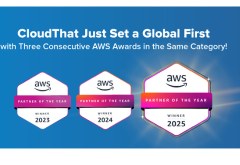Daisy Chittilapilly, Managing Director, Digital Transformation Office, Cisco India explains how her office is bolstering the digital capabilities of different sectors in a pandemic affected world
What are your roles and responsibilities heading the Digital Transformation office at Cisco?
The Digital Transformation office at Cisco curates Cisco’s narrative towards any kind of customer in the consumer space and the enterprise space or in the Public sector space. This includes anybody who wants to bring technology to a space that it is underutilized or not utilized at all to solve problems at scale. So really what the office does is it looks for new challenges, the technology that can be put to solve challenges and new sectors and white spaces, which are right for tech and digital interventions or intermediation. That is really what this office does.
Cisco or has very good customer engagements in traditional large sectors like financial services, IT services, large parts of the government, telecom providers. But sectors like transportation, agriculture, when we started in Smart Cities a few years ago, the urban spaces, utilities, all are very good in adoption of operational technology, but perhaps not so much in terms of IT. Especially in the way they bring the power of IT to solve problems in their core businesses. In the Digital Transformation office, we look for ways and means of how we can push the envelope and boundaries in using tech to solve problems at scale. That in a nutshell is the main job of the Digital Transformation office.
To do that, we have curated solutions which are most impactful in those sectors that we intervene in. We look for customers who have the appetite to co-create and pilot use cases with us. We bring programs like Cisco as a country digital accelerator to support these pilots. We curate ecosystems which complete the solution conversations for customers so that the outcomes are really meaningful. We are trying to bring technology to solve problems at scale and in sectors where it has been under utilized in the past.
How does the Digital Transformation office look at the commercial aspects and how have you witnessed the vertical wise traction in this pandemic situation?
We have been tracking this space globally. Our first study came out in 2013. It was a book called the Digital Vortex, which we had done in conjunction with IMD. As the name suggests, we really took the picture of a vortex and we plotted industries closest to the vortex and further away from the vortex. But what that study told us is that every industry is going to be dis-intermediated by technology.
As you can imagine in 2013, at the center of that whirlpool or the vortex were financial services, media and at the extreme end of that vortex were some of the sectors where my team is focused on now like transportation, agriculture, etc. But without fail, all industries found a place somewhere on that project. The dis-intermediation in financial services and media of course do not need any explaining. We have already seen the way in which the fintechs have taken on the biggest established players, and we have seen that media has gone digital in a very large way. We are just getting started at some of the sectors, but even in those sectors, we have some very interesting pilots which are happening in the country.
These sectors we have traditionally not seen as being as conducive to IT. They are in various stages of adoption but no industry is sitting out. As long as the outcome is interesting into the business, it does not matter in what sector you are. You will find a way to bring technology if you know that the problem worth solving. The office engages in having that conversation with customers on what is the problem to solve and in establishing how much of an impact can technology make in terms of business outcome for the customer. If you get that one right, then it does not really matter in which sector we look at.
But the digital transformation office team gets engaged all the way from that initial conversation of really pinpointing what the problem to solve for us, all the way through curating the solution to setting up a pilot and even sometimes hand holding the commercial model. Sometimes we are also trying on something that maybe the customer and us both have not done. It really depends on the maturity we see in the idea that we are pursuing that determines what part of the sales cycle we are involved in. Once the contract is concluded, then of course we check in to see whether the outcome we had promised is something that has really happened. We want to make sure that the promise to the customer is delivered and that in a nutshell is the degree of our involvement in the sales cycle.
How does the DT office synergize with the other business units at Cisco?
It would be best to describe us as a horizontal business development team, because we cut across all sectors. Having said that, the team has domain expertise especially in the domains they intend to get in. They are horizontal in the way that they can cut across all segments of Cisco. We are largely organized as public sector, telecom, enterprise. The top end of customers in the country are enterprise and everything else was at work commercial and small and medium business. This team really pulls it all together in terms of cross architecture across products, as well as in the sectors that we decide to concentrate. We are between IT and business development people but we do not sit inside the segments of Cisco or inside the product family. We sit outside as a pure business development organization. We do have some creative license in that sense. And if COVID19 has done anything, it has perhaps accelerated the customers’ consumption towards as a service model and cloud has delivered. The good news is we were already on the path as a company to do that.
What are the solutions and services currently in the Cisco portfolio for the Indian market?
We just closed our fiscal year 2020 with about 50 odd %t of our business now coming from software and services, about 30% coming from pure software, and 80% of that software being subscription. So we are more and more aligning towards the customers’ most favorite way to buy. In that sense there is a business model transition, you will see us pushing forward more and more towards making consumption very easy for clients irrespective of the complexity of the technology behind it and making technology itself also very easy to consume. It may be complex in the backend, but for a customer who is using it needs to be easy to use. So easy to use, easy to consume is definitely something that you set out to do about five years ago when our current CEO took over.
We are in line and ahead of our plans too, as to where we wanted to be in terms of makeup of the company, as regards our business. It is 51% today at close of fiscal year 2020, which is a little ahead of where we wanted to be at this point in time. So we are good on that trajectory. And it is very aligned with the way we see customers moving in countries like India also.
In terms of technology, very interesting things are happening in all the spaces that we like to look at. One is in the space of networks, where Cisco perhaps is the most known name traditionally. The most exciting conversations are naturally happening around the latest and best connectivity. Why that is important in a country like India is because it really does push the boundaries of connectivity, it really pushes the availability of bandwidth to consumers. So it is also a necessity that more traditional sectors are getting digitized and as most things are big, bandwidth is definitely necessary and of course, for work from home also it is a necessity. So whole of the next generation technologies that can solve reach and stability of service and bandwidth requirements of the new age are definitely something that Cisco is looking at globally as well as in India.
What is the pattern of changing workloads in a WFH environment and how does it impact the customers moving from on-prem to multicloud environment?
51% of our global revenue now comes from software and services, and in that about 30% is software and 78% of the software is subscription. We were one of the earliest companies to call the term multi cloud. We refused to take a stand on saying that the world will belong to the private cloud or the world will belong to the public cloud. Before COVID19, the customers have been on the path of deciding what workloads should stay within their enterprise and what workloads are amenable to be situated in hosted data centers or public cloud. So this is not a new way of thinking. But certainly because of COVID, enterprises had to scale very quickly to provide capabilities at home for employees to be up and running. So naturally they have had to become cloud-like because they were not sending people to our homes to configure stuff and get us up and running. So we have certainly seen this rethinking that you can have your application in-house, but it has to be cloud-like in delivery.
A lot of companies had to reinvent themselves pretty quickly. And this reinvention is not all done. So while multi-cloud as an idea is not new, but this thinking that all of my infrastructure have to be fairly agile and be fairly available to anybody anywhere now is the determinant. Enterprises have been tested on that capability significantly. They have gotten started, but nowhere all done. So while multi-cloud is not a new idea, but the seriousness which reached the whole enterprise strategy to become multi-cloud capable is certainly on the back of the ability of companies during lockdown to be up and running quickly.
How did Cisco balance between the retention of existing customers and acquisition of new customers?
Our existing customers were the first to knock on our doors when COVID19 hit. But for now we have tracked the trial licenses quite actively and in the trial license anywhere from 20%-30% of people who are using our technology and even buying technology from us commercially are people who have never done business with Cisco. They come from the smallest of companies and from the furthest, from metro points. So there has been a little bit of a flattening of our customer space and a little bit of extension of our customer spaces has certainly happened.
As far as our existing customers are concerned, these are people that we have been talking to sometimes for almost 20 years. So they look to us to bring not just technology but to help them get up and running. As we were an 85% work from home ready company even before COVID19, we have a lot of best practices in terms of how to get this done. So it was not just the technology element, but also the people element or the policy element and a lot of companies looked at us to share all of these perspectives. We have done this very democratically in forums like NASSCOM where a lot of them are customers, but there were people who were not Cisco customers also. We are very generous in terms of taking our narrative to any forum that asked us for best practice sharing from Cisco, not only about technology, but all the other elements of having a work from anywhere culture and readiness best practice.
What were the priority activities for Cisco from a marketing perspective especially in the current situation?
This is a time when we have to stay close to customers and be available for them and at the same time be aware that a lot of the conversations are going to take more time. There are some conversations that have to be had very fast. There are some conversations which will take multiple returns. So staying very close to customers is important and we have tried to avoid any breakage in our customer-facing people.
Our communication rigor internally has also gone up because we are mindful that a person sitting in his/her house can sometimes feel a bit cut off. So for both the employee communication as well as the customer communication element, we have been very conscious in spending as much external time and employee conversations over everything else. In terms of marketing, it was a journey on which Cisco had started on, but in the same spirit of communication, we have also enlisted the partners and customers. We understand social is also our people, our partners etc and so we have also doubled on social.
How has the nature of engagement changed from a DT office perspective from a CIO/CISO to a CDO?
The CIOs and CISOs tend to have a very technology kind of a conversation with Cisco. The big difference I see and that is also changing at high speed where the CIO has a direct line into the CEO and the board. You can see that their vocabulary is also changing at very high speed. Also on the CDO side and the line of business side, where there is no CDOs, we have conversations with say the head of retail in a bank, or the head of a plant and a manufacturing setup, the realization has come that technology is only a means to an end. The questions are no more about what is the great technology that Cisco makes but about the business outcomes.
What will be Cisco’s key focus areas for the next 2-3 quarters with pandemic effect not looking like reducing?
Priorities do not change because when we get into any space, we are not looking at two to three quarter timeframe, because our bets are certainly placed for the longer term. So our bets are the markets we are in and as far as technology is concerned, that is not likely to change. So we are really going to be focused on transforming networks, keeping risk and pay for customers, improving employee and customer experiences and managing the multi-domain world for our customers. Those are the four big technology priorities and there we will continue to augment our offerings and deliver those four outcomes to our customers.
In terms of business model transition, we have already put a flag in the ground saying that we will become more and more a software and services company. We are already 50% and that will go to 60% aspirationally, let’s say 60% in the next 12 months. So that will be a long-term priority and short term execution. This is where we will continue to stay highly engaged with customers, continue to stay relevant, but then digital offers us intermediation opportunities in some more traditional sectors. There are opportunities emerging in non traditional sectors for Cisco. So we will balance and keep close to both and see how we keep our current engagements and current market shares alive there in sectors and technologies, but also go look for new market share and new market segments.
 Latest Technology News Today – Get Latest Information Technology Updates and Services Latest Technology News Today – Get Latest Information Technology Updates and Services
Latest Technology News Today – Get Latest Information Technology Updates and Services Latest Technology News Today – Get Latest Information Technology Updates and Services 









